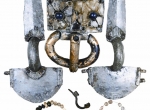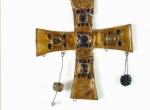Visigoths
Visigoths, alternate names: Tervingi, later, Vesi, “forest Goths”. In late 3rd and the first half of the 4th century they moved from the Black Sea steppes into Moldavia, the Lower Danube region and eastern Transylvania. There, the Sântana de Mureş Culture took form, named after a burial site in Transylvania, very similar to the Cherniakhiv Culture. The royal dynasty of the V. were the Balti; starting from 365 their ruler was Athanaric, who was a judge (rather than king). A man with a V. background was Bishop Ulfilas (born ca. 311) who brought Christianity in its Arian form to the →Goths and translated the Bible into the Gothic language.
When the →Huns drew near Athanaric engaged them on the Dniester but was defeated. Some of the V. separated from their leader and turned to the Eastern Roman Emperor Valens for permission to cross the Danube and settle in Lower Moesia. Once there, oppressed by taxes, they rose up against the Romans; in 378 in the Battle of Adrianople on the Maritsa River they defeated the Romans, the emperor himself was killed. A detailed description of the battle is given by Ammianus Marcellinus. After 382 the Visigoths were settled in Thrace (northern Bulgaria) as allies of Rome but they soon broke the alliance and their young king, Alaric, after laying waste to the Balkans and the Peloponnese and the revolt of a Gothic garrison in Constantinople itself, had to move west, to Italy. After initial setbacks the armies of Alaric captured Rome in 410 and sacked it for three days and three nights. Nevertheless, Alaric’s main aim was Africa as it supplied Italy with corn; making his way to south Italy the king died in Campania. The Visigoths under the leadership of his brother-in-law, Ataulf, made for southern Gaul and, after 418 all southern Gaul passed under their rule. They established a kingdom with a capital at Toulouse. The Visigoths went back to being foederati and in 451 in the Battle of the Catalaunian Plains they were the most faithful allies of Aëtius; their king, Theodoric I, was slain in that battle. The Kingdom of Toulouse flourished under King Euric (466-484) who ruled independent of Rome.
Archaeological finds from the period of the Kingdom of Toulouse are very modest: only a few Gothic brooches, which suggests that the V. soon became Romanized, especially that they drew their income from the great Roman landed estates. For the royal court at Toulouse we have a written testimony of Sidonius Apollinaris, Gallo-Roman poet and aristocrat; relics interpreted tentatively as a palace were discovered in downtown modern Toulouse.
The Kingdom of Toulouse was destroyed by Clovis, king of the →Franks ; in 507, in the Battle of Vouillé near Poitiers, he defeated the V. and slew Euric’s son, Alaric II. The Visigoths moved to the other side of the Pyrenees and established a new kingdom there with Toledo as its capital. They had ventured into Spain before, to plunder or to wage war, as allies of Rome, on the →Vandals and the Alans. The Kingdom of Toledo with its centre in Old Castile took form under Leovigild (568-586), whose son converted to Catholicism. The V. kingdom lasted until the Arab invasion of 711.
The earliest V. finds from Spain are a handful of silver sheet brooches from the 5th century. In late 5th and the first half of the 6th century large cemeteries were established in Old and New Castile: Carpio de Tajo, Duratón (fig. 1.), Casiltierra and Madrona and others. The women kept their traditional costume with two large brooches and a buckle, men’s graves contain no weapons. Starting from the latter half of the 6th century the Visigoth costume goes out of use and Byzantine elements appear, such as cast bronze buckles. A few years ago the remains of Visigoth villages were identified, with houses set over stone foundations and dugouts.
The final phase of the V. Kingdom of Toledo is documented by two hoards of gold objects, discovered at Torredonjimeno (fig. 2.) and Guarrazar (fig. 3.), most notably, several votive crowns, pendant crosses and fragments of a processional cross.
The Kingdom of Toledo is an example of steady Romanization of the V.; during the first half of the 7th century Isidore, the bishop of Seville, already regards them as an integral part of his people.
MM
Literature: V. Bierbrauer, Die ostgotischen Grab- und Schatzfunde in Italien, Spoleto 1975; J. Strzelczyk, Goci – rzeczywistość i legenda, Warszawa 1984; R. Wołągiewicz, Die Goten im Bereich der Wielbark-Kultur [in:] Peregrinatio Gothica, Archaeologia Baltica 84/85, Łódź 1986, p. 63-98; M. Kazanski, La diffusion de la mode danubienne en Gaule (fin du IVe siècle - début du VIe siècle): essai d’interprétation historique, Antiquités Nationales 21, 1989, p. 59-73; P. Périn (ed.), Gallo-Romains, Wisigoths et Francs en Aquitanie, Septimanie et Espagne, Actes des VIIe Journées internationales d’Archéologie mérovingienne Toulouse 1985; V. Bierbrauer, Archäologie und Geschichte der Goten vom 1.-7. Jahrhundert. Versuch einer Bilanz, Frühmittelalterliche Studien 28, 1994, p. 51-171; V. Bierbrauer, Das Frauengrab von Castelbolognese in der Romagna (Italien). Zur chronologischen, ethnischen und historischen Auswertbarkeit des ostgermanischen Fundstoffs des 5. Jahrhunderts in Südosteuropa und Italien, Jahrbuch des Römisch-Germanischen Zentralmuseums Mainz 38, 1995, p. 541-592; A. Kokowski, Schätze der Ostgoten, Stuttgart 1995; V. Bierbrauer, Les Wisigoths dans le royaume franc [in:] F. Vallet, M. Kazanski, P. Périn, (eds.), Des royaumes barbares au Regnum Francorum. L’Occident à l’époque de Childéric et de Clovis (vers 450 – vers 530). Actes de XVIIIes Journées Internationales d’Archéologie Mérovingienne, Bulletin des Antiquités nationales 29, 1997, p. 169-200; J. Tejral, Neue Aspekte der frühvölkerwanderungszeitlichen Chronologie im Mitteldonauraum [in:] Tejral, J. Friesinger, H. Kazanski, M. (ed.), Neue Beiträge zur Erforschung der Spätantike im mittleren Donauraum, Spisy Arheologického Ústavu AV ČR Brno 8, Brno 1997, p. 321-392; A. I. Ajbabin, Etničeskaja istorija rannebizantijskogo Kryma, Simferopol 1999; W. Ebel-Zepezauer, Studien zur Archäologie der Westgoten vom 5.-7. Jh. n. Chr, Iberia Archaeologica 2, Mainz am Rhein 2000; H. Wolfram, Die Goten. Von den Anfängen bis zur Mitte des sechsten Jahrhunderts, München 2001; H. Wolfram, Historia Gotów, Warszawa-Gdańsk 2003; M. B. Ščukin, Gotskij put’. Goty, Krym i černjachovskaja kul’tura, Sankt-Peterburg 2005; J. Kolendo, Plemiona Pomorza w starożytności [in:] Nowakowski, W. et alii (eds.), Goci i ich sąsiedzi na Pomorzu, Koszalin, 2006, p. 17-33; M. Ščukin, M. Kazanski, O. Sharov, Des les goths aux huns: Le nord de la Mer Noire aus Bas-empire et à l’époque des grandes migrations, BAR International Series 1535, Oxford 2006; V. Bierbrauer, Neue ostgermanische Grabfude des 5. und 6. Jahrhunderts in Italien, Acta Praehistorica et Archaeologica 39. Festschrift W. Menghin, 2007, p. 93-124; A. Kokowski, Goci. Od Skandzy do Campi Gothorum (od Skandynawii do Półwyspu Iberyjskiego), Warszawa 2007; M. Mączyńska, Światło z popiołu. Wędrwówki ludów w Europie w IV i V w., Warszawa 2013, esp. p. 221-224, 254-260.
-
 full resolution
full resolution
Fig. 1. Contents of a Visigoth grave from the cemetery at Duratón.
-
 full resolution
full resolution
Fig. 2. Gold votive cross from the treasure from Torredonjimeno.
-
![Fig. 3. Gold votive crown of King Recceswinth from the treasure of Guarrazar. (G. Ripoll Lopez, Archeologia visigota in Hispania [in:] I Goti. Milano 1994, p. 301-327).](http://www.mpov.uw.edu.pl/userfiles/pl/generated/thumbs/150x110_1/Badania/Thesaurus/wizygoci3.jpg) full resolution
full resolution
Fig. 3. Gold votive crown of King Recceswinth from the treasure of Guarrazar. (G. Ripoll Lopez, Archeologia visigota in Hispania [in:] I Goti. Milano 1994, p. 301-327).


